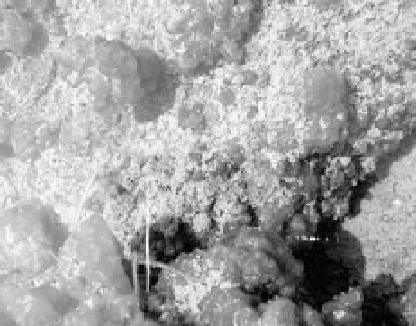Environmental Engineering Reference
In-Depth Information
during the restoration.
Although the public are most interested in fish stocks, another goal of the stream restoration is to
preserve other aquatic biota. Of particular concern are freshwater mussels, many species of which are
threatened and endangered. Mussels are highly sensitive to habitat disturbances. Some of the major
threats faced by mussels are dams, which lead to direct habitat loss and fragmentation of the remaining
habitats, persistent sedimentation, pesticides, and exotic species like fish and other mussel species which
are introduced into the habitat.
10.1.2.3
Habitat
The diversity of available habitats directly influences the biological diversity and abundance in streams.
When a stream system is stably functioning, the diversity and availability of habitats is promoted. This is
one of the primary reasons stream stability is always considered in river ecosystem restoration activities.
Figure 10.9 (a) shows the gravel and cobbles bed of Juma River near Beijing, which is very stable even
during flood events. The stable habitat is colonized by a biocommunity with high diversity. Figure 10.9
(b) shows the Dabai River in the upper Yangtze River basin, which channel bed has a very unstable due
to high sediment load. There is few species in the Dabai River and the biodiversity is low. Under less
disturbed situations, a narrow, steep-walled cross section provides less physical area for habitat than a
wider cross section with less steep sides, but may provide more biologically rich habitat in deep pools.
Habitat increases with stream sinuosity. A uniform sand bed in a stream provides less potential habitat
diversity than a bed with debris dams, boulder cascades, rapids, step-pool sequences, pool-riffle sequences,
or other types of “structures”.
A river may be seen either as a single functioning entity or an ecosystem with components which
interact and have numerous connections between them. In order to restore an ecosystem successfully, one
must not forget these fundamental relations. Certain topographic settings may be more likely than others
to be subject to periodic, dramatic changes in hydrology and related vegetation structure as a result of
massive woody debris jams. The structural aspects of vegetation may affect the functions of the stream
ecosystems. Vegetation and detritus influence the course of water in an undeveloped watershed. Balanced
interactions between terrestrial and aquatic systems result from the mobilization and conservation of
nutrients in complex patterns. Land uses such as agriculture and livestock grazing and the flow patterns
of water, sediment, and nutrients cause the characteristics and distribution of vegetation to change.
(a) (b)
Fig. 10.9
(a) Gravel and cobbles bed of the Juma River near Beijing is stable, which is colonized by a biocommunity
with high diversity; and (b) The Dabai River in the upper Yangtze River basin is very unstable due to high sediment load
and has a very low biodiversity (See color figure at the end of this topic)




Search WWH ::

Custom Search